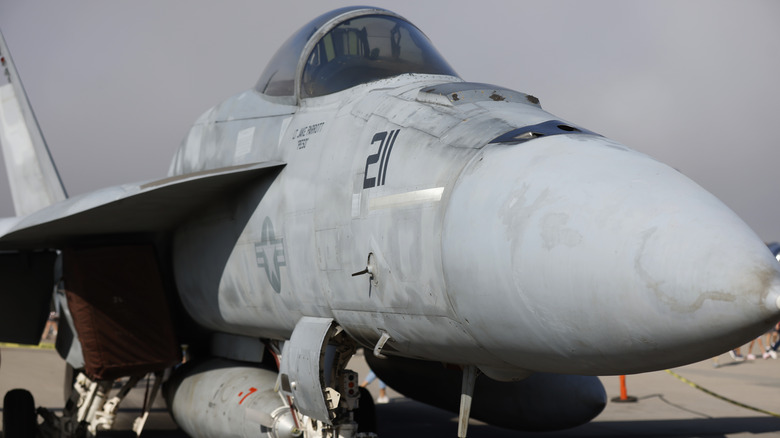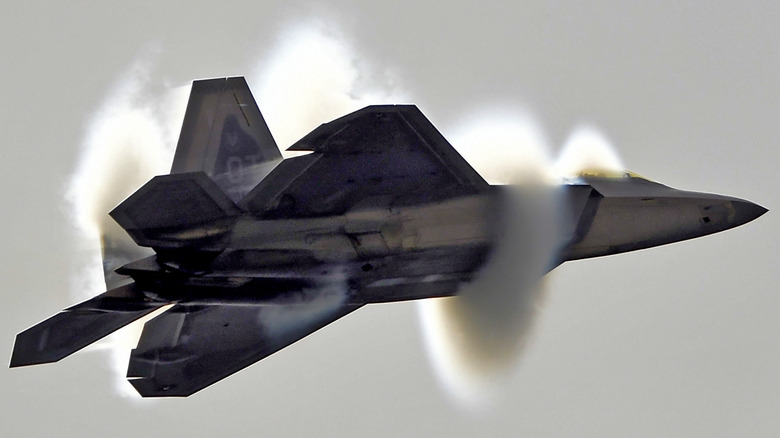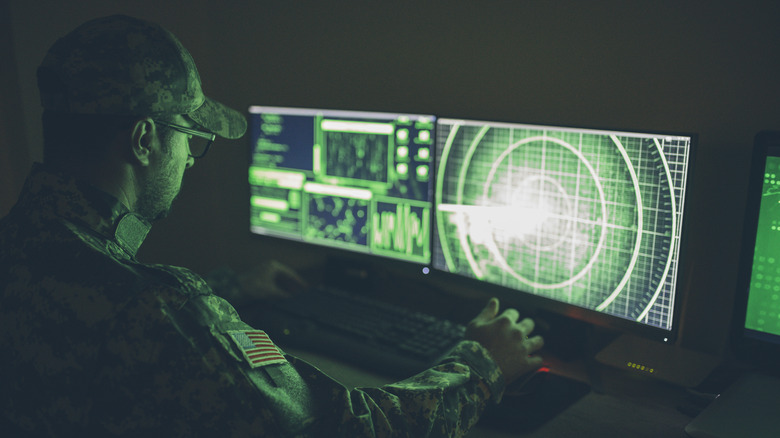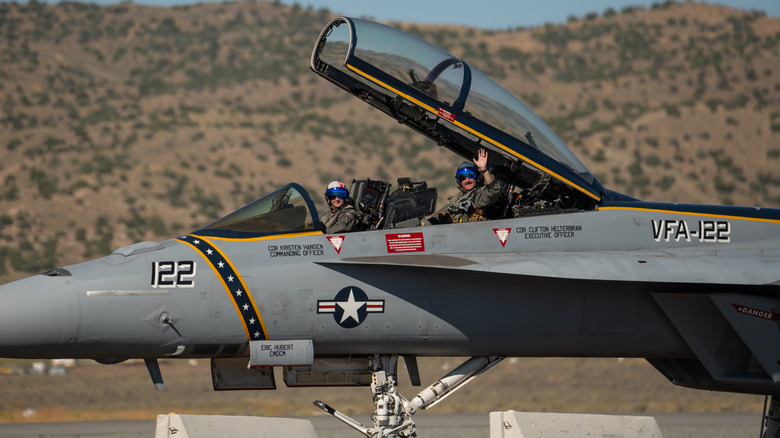The Fascinating History Of The US Navy's Real-Life TOPGUN School
Thanks to the 1986 movie starring Tom Cruise and its 2022 sequel, TOPGUN is a familiar name. Even if you only know "Top Gun" as that fighter-jet movie, you have a good idea what the school is about. But some moviegoers might not realize that it's a real school the Navy sends pilots to.
Before the Vietnam War, the Navy felt its basic flight school was good enough. But when the U.S. entered the conflict over Southeast Asia, those in charge saw their pilots struggling against MiG-17 and MiG-21s, with air-to-air kill ratios dropping from 12:1 all the way down to 3.7:1.
The Navy determined its aviators would benefit from specialized training in air-to-air combat tactics, and the Navy Fighter Weapons School was born. Of course, that's quite a mouthful, so the tactical department of Fighter Squadron 21 created the name TOPGUN. When pilots who attended Navy Fighter Weapons School in 1969 returned to their squadrons, they significantly improved the kill ratio.
What started out as a multi-week course held in a trailer in the parking lot of Naval Air Station Miramar in San Diego eventually expanded into a multi-month course with a whole base dedicated to specialized training. TOPGUN instructors – unofficially known as "Bros" – have trained their students in all aspects of aerial combat, starting with the excellent F-4 Phantom II before expanding to a variety of fighter jets, including the F-35C Lightning II, F/A-18 Super Hornet, F-5 Tiger II, and F-16 Falcon.
Don't believe everything you see in the movies
Unlike a basic flight school, TOPGUN doesn't train its students to return to their squadrons and use their new skills on their own. TOPGUN trains instructors. Pilots who graduate from TOPGUN will either return to their squadrons as instructors and teach everything they learned to their fellow aviators or they have the option to return to TOPGUN as a "Bro" themselves.
Most of those who apply to TOPGUN wait until they have just completed their first fleet tour. After they apply, those in charge select the few they deem the most qualified and send them to the weapon school with either an F/A-18E/F or F-35 Lightning II from their fleet.
While TOPGUN applicants might be competitive, contrary to what "Top Gun" and "Top Gun: Maverick" show, there is no competition among students. They're not outwardly arrogant or show-boaters, nor do they spend their downtime at a bar drinking. They carry themselves with a professional demeanor because they know they're there to learn new skills they will eventually have to teach to others.
If they have any downtime, it's most likely spent catching up on rest or working out to blow off some steam. Their normal day is spent in lectures, debriefs, and flying mission after mission. TOPGUN flights only operate during daylight, with the earliest training missions flown at sunrise. From then on, it's waves of flights after waves of flights, carefully watched by staff.
TOPGUN trains more than pilots
The public knows about TOPGUN because of the pilots it trains, but pilots aren't the only ones receiving specialized training. When students arrive at the Naval Aviation Warfighting Development Center, they're split up into three groups . There are Strike Fighter Tactics Instructors, which is what the movies focus on. We'll refer to them as Strike Fighter students for simplicity. There's also the Adversaries group, which teaches pilots other countries' capabilities and tactics. They typically fly the F-5 Tiger II and are only at the school for nine weeks rather than the 13 weeks Strike Fighter students stay.
Lastly, there are Air Intercept Controllers, who aren't pilots at all. The Controller students don't get the same recognition as pilots since they're on the ground in a simulator looking at a screen, but their role at TOPGUN and in the field is just as vital. They use radar and other sensors to feed information to the Strike Fighter students, giving them situational awareness they might not have otherwise. While Strike Fighter students and Adversaries come from a fighter squadron, those in the Controller group typically come from the E-2 Hawkeye community.
If a graduating student wishes to become a "Bro," they have to retake the entire course with additional material taught to them. There's also the rigorous training to become a subject matter expert, where they can become an expert lecturer on a specific topic.
TOPGUN today
When TOPGUN students return to their squadrons, it's not only lower-ranking officers they train. It's their job to teach the entire aircrew, from the commanding officer to the newest pilot, the skills and tactics they learned in Miramar. Well, now it's Nevada. In 1996, 10 years after the original movie debuted, the TOPGUN training expanded from just air-to-air tactics to air-to-ground strategies to reflect the F/A-18 Hornet and eventual Super Hornet's multi-role missions. This required more airspace and, importantly, more land that Miramar simply didn't have access to.
So the Navy moved the school from Miramar, which has since become the Marine Corps Air Station, to the Naval Air Station in Fallon, Nevada, where it still resides today. In the vast Nevada desert, there's plenty of space for jets to fly and practice air-to-surface tactics. However, TOPGUN still sends students to Miramar, as well as California's Naval Air Station Lemoore and Virginia's Naval Air Station Oceana, for one-on-one basic fighter maneuvers.
TOPGUN typically has 35 instructors on staff, spending an average of three years in the role before moving on from the weapons school. That means less than 5% of all naval aviators get the opportunity to teach at TOPGUN.
Unlike training special forces operatives, such as the Navy SEALs, the point of TOPGUN isn't to weed out the weak. The pilots are there because they're already considered the best of the best. The Navy wants them to graduate, and 90% to 95% of them do.



